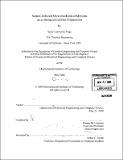| dc.contributor.advisor | Dennis M. Freeman. | en_US |
| dc.contributor.author | Page, Scott Lawrence | en_US |
| dc.contributor.other | Massachusetts Institute of Technology. Dept. of Electrical Engineering and Computer Science. | en_US |
| dc.date.accessioned | 2007-07-18T13:11:52Z | |
| dc.date.available | 2007-07-18T13:11:52Z | |
| dc.date.copyright | 2006 | en_US |
| dc.date.issued | 2006 | en_US |
| dc.identifier.uri | http://hdl.handle.net/1721.1/37926 | |
| dc.description | Thesis (S.M.)--Massachusetts Institute of Technology, Dept. of Electrical Engineering and Computer Science, 2006. | en_US |
| dc.description | Includes bibliographical references (p. 44-45). | en_US |
| dc.description.abstract | The mechanical processes at work within the organ of Corti can be greatly elucidated by measuring both radial motions and traveling-wave behavior of structures within this organ in response to sound stimuli. To enable such measurements, we have developed a new preparation for observing three-dimensional motions of micromechanical structures in the apical region of an isolated gerbil cochlea. The cochlea is submerged in a low-chloride, low-calcium artificial perilymph solution and cemented to the bottom of a Petri dish at an angle. The bone above scala vestibuli of one half of the apical turn is removed to allow optical imaging with a 40x, 0.8 NA water-immersion objective. Reissner's membrane is left intact. Illumination is provided with a blue LED coupled to an optical fiber. The fiber is positioned next to the bone surrounding scala tympani of the apical turn, so that the organ of Corti is illuminated from below. The resulting optical access allows imaging of a variety of structures that have been proposed to play a role in cochlear mechanics, including inner and outer hair cell bundles, the tectorial membrane, inner and outer pillar cells, and efferent fibers in the tunnel of Corti. In some preparations, individual stereocilia of inner hair cell bundles can be resolved. | en_US |
| dc.description.abstract | (cont.) Motions are stimulated by driving the stapes with a piezoelectric probe, and are measured using a stroboscopic computer microvision system. Measurements of sub-micrometer motions of key structures in three dimensions are quantified, including longitudinal motion of the organ of Corti and relative radial motion between the tectorial membrane and hair cells. Longitudinal motion of the Efferent fibers in the tunnel of Corti is found to have a phase lead with respect to the hair cell bodies. This system enables quantitative studies of both the relative motions of structures within the organ of Corti in response to sound and the propagation of traveling waves along structures within the organ of Corti. | en_US |
| dc.description.statementofresponsibility | by Scott Lawrence Page. | en_US |
| dc.format.extent | 57 p. | en_US |
| dc.language.iso | eng | en_US |
| dc.publisher | Massachusetts Institute of Technology | en_US |
| dc.rights | M.I.T. theses are protected by copyright. They may be viewed from this source for any purpose, but reproduction or distribution in any format is prohibited without written permission. See provided URL for inquiries about permission. | en_US |
| dc.rights.uri | http://dspace.mit.edu/handle/1721.1/7582 | |
| dc.subject | Electrical Engineering and Computer Science. | en_US |
| dc.title | Sound-induced micromechanical motions in an isolated cochlea preparation | en_US |
| dc.type | Thesis | en_US |
| dc.description.degree | S.M. | en_US |
| dc.contributor.department | Massachusetts Institute of Technology. Department of Electrical Engineering and Computer Science | |
| dc.identifier.oclc | 136919892 | en_US |
